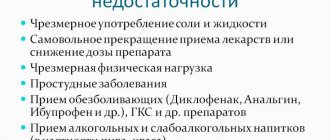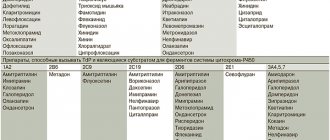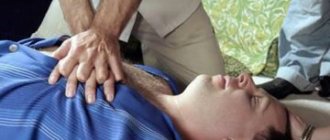Familiarize yourself with other diseases starting with “C”: Sacroiliitis, Salmonellosis, Salpingitis, Salpingoophoritis, Glanders, Beck's Sarcoid, Sarcoidosis, Kaposi's Sarcoma, Ewing's Sarcoma, Diabetes mellitus, Diabetes mellitus type 1, Diabetes mellitus type 2, Mumps, Porcine influenza, rectal fistula, Seborrhea, Sepsis, Cardiac asthma, Heart failure, Sertoli
Cardiac asthma: can it be prevented?
Cardiac asthma manifests itself in the form of attacks of suffocation and shortness of breath caused by left ventricular failure. This leads to stagnation of blood in the pulmonary circulation. Blood plasma penetrates the bronchi and lung tissue, causing pulmonary edema and causing suffocation and difficulty breathing. This pathology requires emergency medical care; if the attack is not stopped quickly, it can be fatal.
Cardiac asthma: causes, symptoms, signs, diagnosis and treatment of pathology at the MEDSI Clinic
Table of contents
- Symptoms of cardiac asthma
- Reasons for development
- Diagnostics
- Treatment
- What to do during an attack?
- Advantages of treating cardiac asthma in MEDSI clinics
Cardiac asthma is a pathology
that is provoked by stagnation of blood in the lungs. The disease is characterized by regular attacks of suffocation. They can occur not only during physical activity, but also in stressful situations, emotional stress and even slight anxiety. Often attacks occur in a state of complete rest when the patient is sleeping. This is due to the fact that at night, during stress and vigorous activity, blood actively flows to the lungs. During an attack, the duration of which varies from 2-3 minutes to 1-3 hours, the patient experiences problems breathing, feels fear of death and coughs frequently.
Cardiac asthma is a disease, some symptoms of which occur at least once in approximately 3% of the world's population. Pathology occurs with approximately equal frequency in representatives of both sexes. As a rule, the complication occurs in people over 55 years of age.
Important! Cardiac asthma - a complication
, not a separate state. It occurs with pneumonia, hypertension, heart defects and other serious diseases. Cardiac asthma is often confused with bronchial asthma. For this reason, it is very important to consult a doctor and conduct a comprehensive diagnosis.
Since the pathology is dangerous and can cause sudden death, it is important to contact a specialist at its first manifestations. You should not wait for the attacks to recur!
Symptoms of cardiac asthma
The main signs of the pathological condition include:
- Prolonged exhalation and difficulty in inhaling air, causing severe discomfort and severe shortness of breath
- Choking caused by prolonged painful cough
- Pale skin
- Swelling of veins in the neck
- Sweating
- Bluishness (usually the skin of the fingers and lips)
If the critical condition occurs at night, the patient suddenly wakes up due to the fact that he cannot breathe normally, and this causes him to instantly experience a panic attack. Often patients try to “breathe” near an open window. Such actions do not bring relief, since the pathology is in no way related to the lack of oxygen in the room.
Reasons for development
Pathology can manifest itself as a complication of diseases of the cardiovascular and other systems.
To the main reasons for its development
include:
- Heart failure
- Myocardial infarction
- Ischemic disease
- Aneurysms
- Heart defects
All these pathologies lead to the inability of the heart to contract normally (in an optimal manner). As a result, sufficient blood flow is not ensured, and it accumulates in the lungs, which provokes regular attacks.
Other causes of the disease include blood clots in the heart and organ tumors. Such formations become barriers in the veins to the path of blood.
Provoke an attack
can:
- Hypertension, in which blood pressure rises and the arteries become congested
- Various types of strokes and other brain injuries that affect control of lung function
- Infections (pneumonia, for example) leading to swelling
Seizures are often caused by:
- Emotional stress
- General fatigue
- Eating a lot of food before bed
- Violation of fluid intake (especially in hypertensive patients)
These factors also stimulate blood flow to the lungs.
There are a number of other reasons for the development of complications. The doctor will tell you everything. He will also determine the cause of the pathological condition in your case. To do this, he will conduct a conversation and examination, and also interview you. The consultation will allow you to determine the causes of the pathology and quickly find a way to eliminate it.
Diagnostics
Recognizing a pathological condition such as cardiac asthma is quite difficult. This is due to the fact that the complication has common symptoms with a number of other diseases (even attacks of hysteria).
Diagnostics is always carried out comprehensively and includes:
- Inspection
. The doctor diagnoses such signs of pathology as pallor and bluishness of the skin, activation of additional muscles when inhaling, increased blood pressure - Listening
. At this stage of diagnosis, the doctor notices unusual wheezing in areas where there is congestion, changes in heart sounds, and an increase in heart rate (up to 150 beats per minute) - ECG
. This examination is one of the most revealing. It allows you to detect signs that indicate changes in heart function - Echocardiography
. This examination is also called “ultrasound of the heart.” As part of the diagnosis, the specialist detects valve defects, changes in the thickness of the walls of the left part of the muscle and a decrease in its contractility - Duplex scanning
. This diagnosis makes it possible to determine the pressure in the heart, decreased blood volume and other factors indicating the presence of pathology. - X-ray examination
. X-rays are taken in 3 projections. Thanks to this, the doctor receives a complete picture of the functioning of the heart and lungs and detects congestive processes
Treatment
Treatment of complications should begin as early as possible
, after the occurrence of the first attack.
Basic first aid measures are aimed at:
- Improving heart function
- Relieving nervous excitement
- Preventing Pulmonary Edema
Further therapy is aimed at:
- Relieving vascular spasm
- Lower blood pressure
- Elimination of discomfort (heart pain and shortness of breath)
- General relaxation
- Reduce swelling
- Decreased heart rate
Cardiac asthma, the treatment of which should not be delayed, is often accompanied by a number of concomitant pathologies. It is important to carry out their therapy. For this reason, treatment is always comprehensive.
It includes:
- Taking medications to relieve major symptoms
and reduce the risk of attacks - Inhalations to prevent oxygen starvation
of the body - Taking medications that help remove excess fluid
and relieve swelling - Administration of drugs to relieve nervous excitability
Therapy is always selected taking into account the patient’s general condition, the presence of concomitant diseases and individual characteristics.
What to do during an attack?
The patient's relatives should have some knowledge and skills to reduce the symptoms of an attack and alleviate the patient's condition.
Remember 4 simple rules!
- At the first sign
of an attack, call an ambulance - Provide a flow of fresh air
into the room in which the patient is located. Be sure to take off your clothes. If you are outside, unfasten the patient's clothing. - Create conditions so that the patient can take a comfortable position
(in a chair or on a bed). Make sure to keep your legs down. This will stimulate blood flow and improve the patient’s condition. - Remove foam and mucus from the mouth (if any)
If a critical condition has not occurred for the first time, and the patient already has specific recommendations from a cardiologist, they should be strictly followed. Doctors often advise additionally dissolving a nitroglycerin tablet or taking validol, for example.
Important! You should not refuse hospitalization, as the acute condition may recur in the near future or drag on.
Advantages of treating cardiac asthma in MEDSI clinics
Cardiac asthma, which is treated in our clinics, is a dangerous pathology. We pay special attention to it and constantly use both traditional and innovative therapy methods.
- Specialists are ready to provide quick assistance to the patient
. You can call a team that will perform all necessary (including resuscitation) actions - We have a comfortable hospital
for complex treatment of cardiac asthma - The basis of the work of MEDSI cardiologists is extensive experience in diagnostic and therapeutic practice
using modern equipment from the USA, Japan, Germany and Russia - We have the capabilities to provide both drug and surgical therapy
(including minimally invasive interventions)
To undergo treatment, just make an appointment with a cardiologist by calling + 7 (495) 7-800-600.
Causes of the disease
Factors provoking pathology are:
- Cardiac ischemia;
- Mitral stenosis;
- Cardiac aneurysm;
- Acute myocardial infarction;
- Exacerbation of chronic glomerulonephritis;
- Post-infarction conditions;
- Paroxysm of atrial fibrillation;
- Cardiosclerosis;
- Defect or deficiency of the heart valves;
- Atrial flutter;
- Heart failure provoked by increased physical activity, horizontal body position or intravenous administration of a large volume of fluid;
- An increase in the blood mass filling the vessels.
Causes and symptoms
Cardiac asthma is called nocturnal because when the patient lies down, swelling occurs due to excessive accumulation of fluid in the vessels of the lungs. The cause of shortness of breath may be depression of the respiratory center during sleep.
The most common symptoms include the following:
- Shortness of breath during physical exertion, as well as when lying down (shortness of breath goes away if you take a vertical position).
- Night sleep is disturbed, the patient often wakes up.
- Whistling in the lungs and a hoarse cough with a lot of sputum, which may contain blood.
- The patient may constantly feel a lack of air and feel the need to ventilate the room.
- Chest pain, arrhythmia.
- Drowsy, tired state, swelling of the legs may occur.
To diagnose cardiac asthma, it is necessary to do an ECG, as well as a number of additional examinations.
Characteristic symptoms
Cardiac asthma attacks most often occur at night. They are accompanied by:
- Dry cough;
- By suffocation;
- Cyanosis, that is, blue discoloration of the fingertips, face and nasolabial triangle;
- Pale skin;
- Hard breathing caused by swelling in the lungs;
- Moist rales in the lower parts of the lungs;
- Reflex bronchospasms.
Diagnosis is complicated by the fact that similar symptoms also occur with bronchial asthma. If an attack occurs, you must immediately call a doctor.
Symptoms
The main manifestations of cardiac asthma are:
- sudden attacks of shortness of breath, occurring mainly at night, when the patient moves to a horizontal position;
- a feeling of acute lack of air, turning into severe shortness of breath and suffocation;
- orthopnea – the patient takes a forced sitting position and cannot sleep in a horizontal position;
- dry cough, mainly in the morning;
- “decapitated” hypertension - high diastolic blood pressure with normal or slightly elevated systolic;
- lungs;
- excitement, cyanosis, cold sweat, tachycardia, fear of death.
dry or scanty small bubbling rales, mainly in the lower areas
In severe cases without treatment, cardiac asthma can be complicated by alveolar pulmonary edema, the symptom of which, in addition to shortness of breath, is bubbling breathing with the release of foamy pink sputum.
Treatment
Therapy for cardiac asthma includes:
- Immediate medical assistance to stop the attack;
- Taking medications that relieve an acute condition: nitroglycerin, nifedipine;
- Subcutaneous or intravenous administration of furosemide;
- Oxygen inhalations;
- Administration of cardiac glycosides;
- If heart rhythms are abnormal, defibrillation is indicated.
When an attack first occurs, hospitalization is required. For the treatment of cardiac asthma, it is necessary to correctly identify the disease that provokes this condition and its treatment. Unfortunately, in many cases the outcome is unfavorable, but with complex therapy and lifestyle correction, repeated attacks can be avoided, work capacity can be maintained, and well-being can be maintained for several years.
The danger of cardiac asthma
This pathology has a high risk of death, which can only be avoided with timely medical care.
Diagnosis and treatment
For proper treatment, it is important to differentiate cardiac asthma from bronchial asthma, acute laryngeal stenosis, and from shortness of breath in other diseases. Only an experienced doctor can make a correct diagnosis, excluding similar diseases. Diagnosis begins with analysis of data from an objective examination and collection of anamnesis. Hardware and laboratory tests are prescribed:
- chest x-ray; c
- electrocardiographic study;
- echocardiography;
- ABPM – daily blood pressure monitoring;
- ultrasonography;
- spirography (to exclude bronchial asthma);
- General and biochemical blood test.
If you have an attack of cardiac asthma due to the high risk of developing pulmonary edema, you must urgently call a doctor. The main way to combat the disease is medical conservative treatment; hirudotherapy also has a good effect. For cardiac asthma, inhalations are indicated to help reduce pulmonary edema.
For cardiac asthma with rhythm disturbances, electropulse therapy is used; in case of valve disease, consultation with a cardiac surgeon and surgical intervention are indicated.
Make an appointment
Your message has been sent
Thank you for contacting Multidisciplinary Medical!
Your message will be processed shortly and we will contact you to clarify the details.
Be healthy!
Join us on social networks!
Current news, promotions, useful information.
How to find us
OUR ADDRESS
Moscow, st. Shchukinskaya, 2
Shchukinskaya, Streshnevo, Sokol
TELEPHONE
+7
Diagnostics
Cardiac asthma in its clinical progression may be similar to low-grade asthma. For example, lack of breath and other signs of shortness of breath are also characteristic of bronchial asthma. Violent breathing and panic attacks often intensify during a hysterical attack. Other similar signs may be mistaken for SA for laryngeal stenosis or mediasthenic syndrome.
In making a correct diagnosis, we are first aided by the patient's history of illness. It is known that the patient had early history of hypertension or heart failure, so the development of cardiac asthma is highly likely. When the SA attacks, it is difficult to carry out diagnostics, the fragments in the first blood are to blame for the attack on the buttocks. However, doctors conduct a thorough objective examination of the pulse, evaluate the mucous membrane and skin, listen to the breath and heart tones.
An important diagnostic criterion that indicates the presence of cardiac asthma is the appearance of the first attacks in adulthood. Also, such patients almost always have another cardiac pathology.
With AS, the following changes may occur:
- The pulse is thread-like or weakly palpable.
- Tony's heart is muffled, you can hear the rhythm of a gallop.
- Arterial pressure on the kidney is indicated as movement, and then decreases.
- In the lungs, you may hear either wheezing or dry irritation.
To clarify the diagnosis, instrumental methods of investigation must be carried out. Firstly, electrocardiography, which shows characteristic signs of left ventricular insufficiency, arrhythmia or myocardial ischemia.
If possible, take a chest x-ray. The image will show signs of blood stagnation in a small amount of blood circulation: enlargement of the root of the legs, thickening of the leg muscles, and the contours of the heart may change.
Pathogenesis
In a number of severe cardiological illnesses, insufficiency of the left ventricle is formed, which does not allow the weakened muscle of the ventricle to drain from the leg veins, causing a large blood loss. As a result, blood stagnation occurs in a small amount of blood circulation, and blood plasma leaks into the alveoli of the lungs. In especially important episodes, liquid accumulates in the bronchi. All this sounds characteristic of cardiac asthma, manifesting itself in the appearance of the buttocks, coughing and coughing.
The movement of the blood pressure in a small amount of blood flow provokes a reflex reaction, when the vessels in the alveoli are rushed. This organism tries to avoid further transudation of plasma into the tissues of the lungs. A similar compensatory reaction is known as the Kitaev reflex.
In fact, it is created more viciously, as the fragments create a stronger pressure in the leg veins, the stronger the reaction of the body in the form of Kitaev’s reflex. The more the arterioles are pressed, the greater the pressure on the veins of the lungs, which leads the blood to the left ventricle. Due to the weakness of the myocardium, a complete shortening and even worsening of the situation with a high pressure in a small amount of blood flow cannot be achieved.
The following officials can improve the health of the sick:
- Movements instead of liquid in the body (hyperhydration, complicating the process of removing liquid from the body).
- Increased blood flow on the surface of the small stake when occupying a horizontal position.
- Disorder of central regulation, which occurs more often during sleep.
- Physical or emotional attraction.
Cardiac asthma is accompanied by rapid heart rate and breathing, hypertension, and increased activity of the respiratory muscles. In addition, during the hour, breathing is required to observe the effect of forced inhalation, which in turn promotes the blood flow of the small vessels. In this case, central neuroregulation begins to break down, which gradually weakens the activity of the heart. As a result, cardiac activity becomes less effective, and the patient’s condition becomes even worse.
Prognosis and prevention
The outcome of the pathology is determined by the underlying disease, which provokes attacks of suffocation. Most often, the prognosis for cardiac asthma is unfavorable. In some cases, strict adherence to the restrictive regime and comprehensive treatment of the underlying disease can prevent the development of repeated attacks and maintain working capacity for many years. Prevention of attacks is based on timely and competent treatment of arterial hypertension, coronary artery disease with symptoms of heart failure, patient compliance with the water-salt regime and prevention of the development of infectious diseases.
Emergency first aid for an attack of cardiac asthma
The first step is to call an ambulance and inform the dispatcher about the age and location of the victim. It is also advisable to talk about the symptoms that the patient has. Then you should unbutton your shirt, remove your belt, tie and other accessories that block the person’s breathing.
After this, you need to open a window in the room so that the victim can breathe in fresh air, while it is advisable to turn on a fan or wave a notebook, cardboard paper or hat in front of the person’s face. These manipulations are needed to eliminate oxygen starvation in the brain.
The patient should not be in a horizontal position; he should be seated on a couch or bed so that his back rests on the back of a chair or pillow. If a person becomes ill on the street, he should be seated on a bench, high curb or stump.
When providing first aid for cardiac asphyxia, special treatment of the oral cavity is important. If the patient accumulates a large amount of foam and phlegm in the mouth, it should be removed with cotton pads or other sterile objects. It is not recommended to do this with your fingers, as this is unhygienic and the victim may reflexively clench his jaw due to pain shock.
To ease the work of the heart, normalize blood circulation and prevent pulmonary edema, you need to apply tight tourniquets to the lower and upper limbs (one limb should be without a tourniquet). After 10-15 minutes, the tourniquets should be transferred and the other limb should be left free. This manipulation must be carried out simultaneously, and the tourniquets on the lower extremities must be fixed at a distance of 15 centimeters from the groin. On the upper limbs, the tourniquet is installed at a distance of 10 centimeters from the shoulder joint.
If the procedure was carried out correctly, the pulse will be felt just below the applied bandage. Due to manipulation, the skin should become red-bluish. The duration of the procedure varies from 5 to 30 minutes. During an attack of cardiac asthma, tourniquets can be replaced with hot baths for the lower extremities. This manipulation will help reduce blood flow to the heart.
If a person does not get better, he needs to be urgently hospitalized for medical care. Even if the victim’s health has improved, it is necessary to consult a specialist and undergo an examination to find out the cause of suffocation. After delivering the patient to a medical facility, the cardiologist will conduct a general diagnosis of the whole body. First of all, the specialist will talk with the patient, find out about the symptoms and the attack, then the doctor will need test results: electrocardiogram, chest x-ray, ultrasound of the heart, magnetic resonance imaging to detect problems and hidden diseases. After the examination and receipt of research results, the patient is sent to the attending physician, who makes an accurate diagnosis and prescribes a comprehensive course of therapy.







